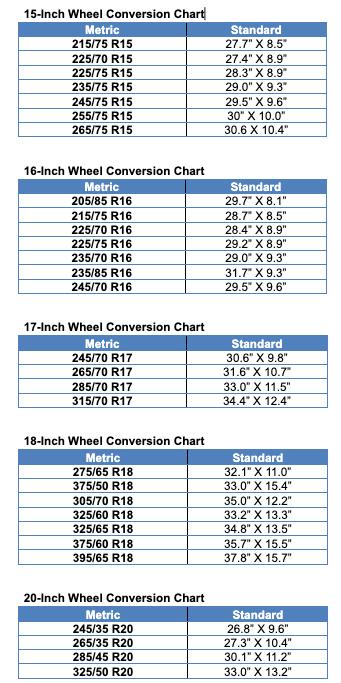Contents
What Do Tire Sizes Mean?
An imperial-sized tire (using US customary units in inches) may look something like this:
28.7 x 8.5 – 16. Here’s what these numbers mean.
- 28.7 = tire diameter in inches
- 8.5 = section width in inches
- 16 = wheel size in inches
Or, you may see something like this: 215/75 R 16. This is the metric measurement, and the numbers mean the following:
- 215 = tire width in millimeters
- 75 = aspect ratio (this tire’s height is 75 percent of its width)
- 16 = wheel size in inches
In other words, the imperial tire size and the metric measurement are two ways to describe the same dimensions.
Standard to Metric Tire Conversion
If you only know the standard tire size but you need metric numbers, then it’s time for some math. Let’s use the tire in the example above: 28.7 x 8.5 – 16.
- Start by converting the section width from inches to millimeters. To do this, multiply the section width (in inches) by 25.4 (the number of millimeters in an inch).
Answer: 8.5 x 25.4 = 215.9 mm - Next, determine the sidewall measurement, which is the tire diameter minus the wheel size, divided by two.
Answer: (28.7-16) / 2 = 6.35 - Finally, divide the sidewall measurement by the section width and multiply by 100. That will give you the aspect ratio.
Answer: 6.35 / 8.5 x 100 = 75
Combine these numbers to determine the metric tire conversion. In this case, use 215/75 R16 as the metric tire size.
Metric to Standard Tire Conversion
Standard imperial sizes are laid out plainly. For example, a 33 x 10 – 16 tire measures 33 inches tall, is 10 inches wide, and sits on a 16-inch wheel.
The metric measurement of these tires can be more complicated. Looking at a 255/85 R16 tire size doesn’t give you a lot of information.
You know that the tire is 255 mm wide. The sidewall height is 85 percent of the width, but that typically doesn’t mean much to us visually. What we do understand is that this tire sits on a 16-inch wheel. To fully understand the rest, you may need to do a conversion.
Here’s how to convert a tire into inches using our example of a 255/85/R16 tire.
- First, find the tire diameter by multiplying the tire width by the aspect ratio, then dividing by 2540 and multiplying by two. Add the wheel size. In this example:
Answer: (255 x 85 / 2540 x 2) + 16 = 33 - Next, determine the section width by dividing the tire width by 25.4.
Answer: 255 / 25.4 = 10 - Last, note the wheel size: 16
Using this method, our 255/85 R16 becomes 33 x 10 – 16, or a 33-inch tire that’s 10 inches wide on a 16-inch rim.
Popular Tire Size Equivalents
While you can use a metric tire conversion calculator, it’s just as easy to utilize charts. Here are a few of the most popular tire sizes and the corresponding conversions.
If you need a conversion not listed in these charts, use the equations above.
Why Do Some Tires Use Metric Measurements?
Most of the world uses meters and millimeters, while the United States holds firm to feet and inches. Both are used for tires, and measurement standards have subtle differences.
For decades, the United States produced most tires. For this reason, the US Department of Transportation was responsible for industry terminology related to tires. In the 1960s, wheel sizes were written in inches, along with the tread width. Aspect ratio wasn’t around then. All tires had the same sidewall measurement of 90.
Soon, European countries started producing better radial tires. Companies wanted to sell in the United States, but the legal requirement was that wheel sizes be written in inches. This law forced Europeans to change one measurement to inches and leave the rest in millimeters.
Even tires produced in the United States started using mixed-up millimeter and inch measurements. This mashup was done so the tires could be sold to Europeans.
So, where did the aspect ratio come from? As radial technology made utilizing shorter sidewalls and wider tires easier, aspect ratio became necessary.
Now that you know all about your tire sizes, it’s easy to pick the right tires for your ride. eBay Motors has a top-notch selection of all the best tires—in any size.
Shop now for tires





